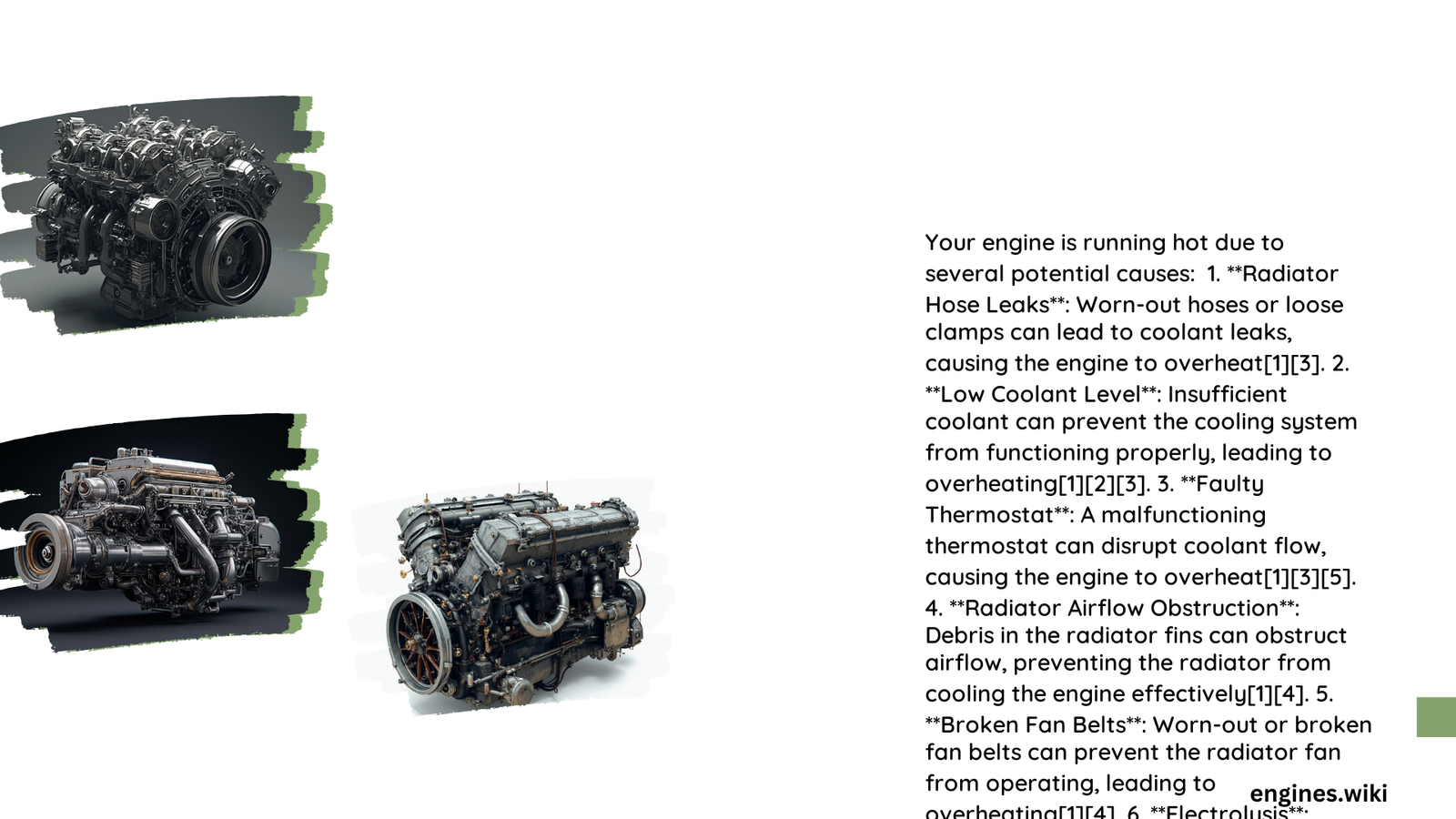An overheating engine is a serious issue that can lead to significant damage if not addressed promptly. This article explores the common causes of engine overheating, signs to watch for, and effective solutions to prevent and address the problem. Understanding why your engine is running hot and how to handle it can save you from costly repairs and potential breakdowns.
What Are the Common Causes of Engine Overheating?
Engine overheating can stem from various issues within the cooling system or engine components. Here are some of the most frequent culprits:
- Low coolant levels
- Faulty thermostat
- Radiator problems
- Cooling system leaks
- Malfunctioning water pump
- Broken fan belt
- Clogged coolant passages
How Does Low Coolant Affect Engine Temperature?
Low coolant levels are a primary cause of engine overheating. The coolant, a mixture of water and antifreeze, is responsible for regulating engine temperature. When coolant levels drop below the minimum mark in the reservoir, it can lead to:
- Inadequate heat absorption from engine components
- Reduced circulation through the cooling system
- Increased friction and heat generation within the engine
To prevent this issue:
- Regularly check coolant levels
- Inspect for leaks under the vehicle
- Top up coolant when necessary, using the correct type for your vehicle
What Role Does the Thermostat Play in Engine Temperature?
The thermostat is a crucial component in regulating engine temperature. It controls the flow of coolant between the engine and radiator. A faulty thermostat can cause overheating in two ways:
- Stuck closed: Prevents coolant from flowing to the radiator for cooling
- Stuck open: Allows constant coolant flow, preventing the engine from reaching optimal operating temperature
Signs of a faulty thermostat include:
- Fluctuating temperature gauge readings
- Engine taking longer to warm up
- Overheating at idle but cooling when driving
How Can I Identify Signs of Engine Overheating?

Recognizing the signs of an overheating engine early can prevent severe damage. Here are key indicators to watch for:
- Temperature gauge in the red zone: The most direct indicator of engine overheating
- Steam from under the hood: Indicates boiling coolant
- Sweet, syrupy smell: Often a sign of leaking coolant
- Engine performance issues: Loss of power or rough running
- Warning lights: Temperature or check engine light illumination
What Should I Do If I Notice These Signs?
If you observe any of these signs while driving:
- Turn off the air conditioning and turn on the heater (to draw heat away from the engine)
- Pull over safely and turn off the engine
- Allow the engine to cool for at least 15 minutes
- Check coolant levels (only when the engine is cool)
- Call for roadside assistance if necessary
How Can I Accurately Check Engine Coolant Temperature?
Monitoring engine coolant temperature is crucial for preventing overheating. Here’s how to do it effectively:
- Use the dashboard gauge: Most vehicles have a temperature gauge that indicates coolant temperature
- Check the coolant reservoir: When the engine is cool, verify the coolant level is between the min and max marks
- Use an OBD-II scanner: For more precise readings, use a diagnostic tool to read coolant temperature data
What Is the Ideal Engine Temperature Range?
The optimal engine temperature range varies by vehicle but typically falls between:
- 195°F (90°C) and 220°F (104°C)
Consult your vehicle’s manual for the specific recommended range.
What Are Effective Solutions for Engine Overheating?
Addressing engine overheating requires identifying and fixing the root cause. Here are some solutions based on common issues:
| Problem | Solution | Estimated Cost | Time Frame |
|---|---|---|---|
| Low coolant | Refill and check for leaks | $20 – $50 | 30 minutes |
| Faulty thermostat | Replace thermostat | $200 – $500 | 2-3 hours |
| Radiator issues | Clean or replace radiator | $300 – $1,000 | 3-6 hours |
| Cooling fan failure | Replace fan or switch | $100 – $300 | 1-2 hours |
| Water pump failure | Replace water pump | $300 – $750 | 4-6 hours |
How Can I Prevent Future Engine Overheating?
To minimize the risk of engine overheating:
- Maintain regular coolant flushes and replacements
- Inspect hoses and belts for wear and replace as needed
- Keep the radiator clean and free of debris
- Address any unusual engine noises or performance issues promptly
- Use the correct coolant type for your vehicle
- Avoid overloading your vehicle, especially in hot weather
By following these preventive measures and staying alert to the signs of overheating, you can keep your engine running at the right temperature and avoid costly repairs.
Remember, if you’re unsure about diagnosing or fixing engine overheating issues, it’s always best to consult a professional mechanic. They can provide expert diagnosis and ensure that repairs are done correctly, protecting your engine from potential damage.
References:
1. Goodyear Auto Service – Engine Overheating Causes and Actions
2. CarAdvise – Engine Overheating: The Complete Guide
3. AMSOIL Blog – Why is My Engine Overheating?
